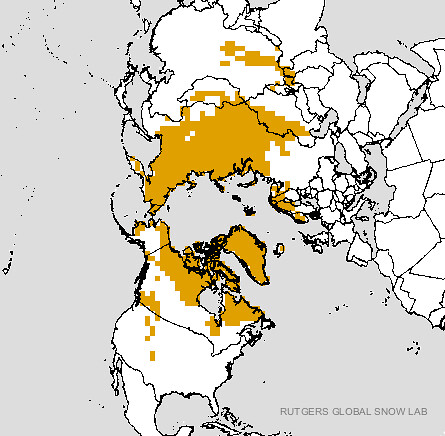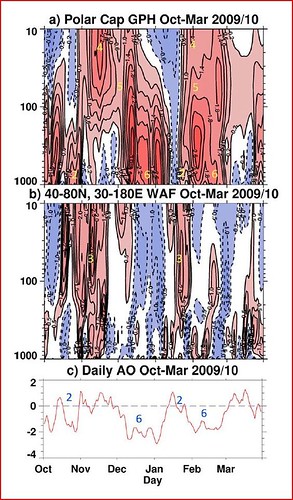Though observed global temperature trends continue toCohen et al 2010.
warm with no observed reversals (according to NOAA,
globally it was the fifth warmest December–February (DJF)
period), public perceptions were clearly influenced increasing
skepticism towards global warming (e.g., New York Times
Feb 10, 2010; Wall Street Journal Feb 16, 2010). Therefore,
we would argue that attribution of the harsh winter weather is
critical to the debate of anthropogenic climate change.
The winter of 2009/10 was very unusual. It was dominated by a low index Arctic Oscillation (AO), the value for February being -4.27 (NOAA), the lowest since records began in 1950. The winter was dominated by this negative AO and the consequently weak polar vortex, which allowed cold Arctic air masses to spill out into mid latitude regions causing extensive disruption due to cold and snow, while inflowing air warmed the Arctic. Cohen et al 2010 provides an explanation of why this happened.
Dr Judah Cohen has argued hard in a series of papers for acceptance of his theory that anomalous Siberian snowfalls change surface properties and hence impact the interaction between atmosphere and surface, causing the Arctic Oscillation (AO) to move to a negative index.
In October 2009 there was a massive snowfall in Siberia during the last two weeks, this can be seen using the following two plots from Rutgers Snowlab.
17/10/09
27/10/09
Rutgers Snowlab snow cover plots for 17 and 27 October 2009, snow extent in yellow.
As can be seen, between 17/10/09 and 27/10/09 there was a massive fall of snow, this is the initiator of the process Dr Cohen describes. Figure 1 of Cohen et al demonstrates the flow of interactions in the process.
Cohen et al 2010, Figure 1. Panel a shows geopotential height changes, panel b shows movement of atmospheric waves, panel c shows the daily Arctic Oscillation index.
Stage 1 is the massive snowfall across Siberia during the last two weeks of October. Stage 2 is the initial atmospheric response to that; surface temperatures in Siberia went from being above average to below, this lead to the development of a region of high pressure over the region. Stage 3 is shown in panel b; this was an upward moving train of atmospheric waves that translated the surface high pressure into impacts upon the stratosphere. By stage 4 the process was affecting the stratosphere substantially, leading to a dipolar pattern of warming centred on the Canadian Arctic Archipelago and cooling over Siberia. I don't think this has anything to do with the surface Arctic Dipole. At stage 5 the stratospheric temperature and pressure changes lead to changes in the atmospheric column that propagate downwards into the troposphere, until at stage 6 a negative index AO becomes apparent in the surface pressure fields. The process then repeated a second time leading to the second cold wave that affected the mid latitudes of the Northern Hemisphere during January.
In a recently published paper Jung et al use the European Centre for Medium-Range Weather Forecasting (ECMWF) model to examine whether the cold winter of 2009/10 was forced from outside the North Atlantic region. Aside from atmospheric modes they examine whether changes in UV insolation or Siberian snowfall could be involved in that winter. To test UV radiation they reduce UV B & C by 4% and 6% respectively. To test the issue of snowfall the model is forced using reanalysis temperatures for the lowest 300 metres of the atmosphere. They find that neither effect causes the model to meet observed indices, indicating that both factors are small.
The theory that low solar UV played a role is not about the specific initiator of the extreme low AO event but more about a bias that makes such events more likely. So a study examining one year is not instructive, to identify such a bias many years must be used to overcome the 'noise' from natural variability and bring the possible UV role to the fore. However crucially they note that whilst ECWMF was able to give good prediction once the extreme low AO event had started, it was "poor to modest" in predicting the onset of the negative AO winter. I suggest that this means it is possible that ECWMF may not be able to tell us much of use about the initiation of the extreme low AO event. In my opinion Jung et al's argument against Cohen et al is not strong.
A good test of any theory is it's ability to predict. For the 2009/2010 season Dr Cohen made a good prediction of the winter after the Siberian snowfall, prior to that snowfall he had predicted a warm winter. His 2009/10 prediction is here. However his prediction for 2010/11 was less successful, here, he gives reasons below the two graphics. No weather prediction is ever going to be 100%, the only way to give a fair test is to obtain years worth of data and do the statistics to allow for extraneous factors.
Dr Cohen's work strongly suggests that Siberian snowfalls are an initiator for low index AO events that cause cold winters in the mid-latitudes of the Northern Hemisphere. More than that Cohen et al suggests that the process leading to winter 2009/10 did not start in the stratosphere due, for example, to reduced UV insolation, but in the troposphere: Specifically Siberia, due to an extensive snowfall. This however does not rule out a role for reduced insolation.
Whilst Siberian snowfall can be considered an initiator both reduced UV insolation and reduced sea-ice have atmsopheric impacts that may act as a background bias towards a low index AO state. As I will discuss in my next post, the atmospheric effects of reduced sea-ice are real and cannot be ignored.
Cohen et al, 2010, Winter 2009-2010: A case study of an extreme Arctic Oscillation event.
http://web.mit.edu/jlcohen/www/papers/Cohenetal_GRL10.pdf
Jung et al, 2011, Origin and predictability of the extreme negative NAO winter of 2009/10.
ftp://ftp.astr.ucl.ac.be/publi/2011_05_09-12h15-hugues.goosse-11.pdf
More reading:
Judah Cohen in The New York Times.
With regards the above link, for a chuckle read Pielke Snr's smoke and mirrors attack on Cohen.
Washington Post, Capital Weather Gang, article.



No comments:
Post a Comment